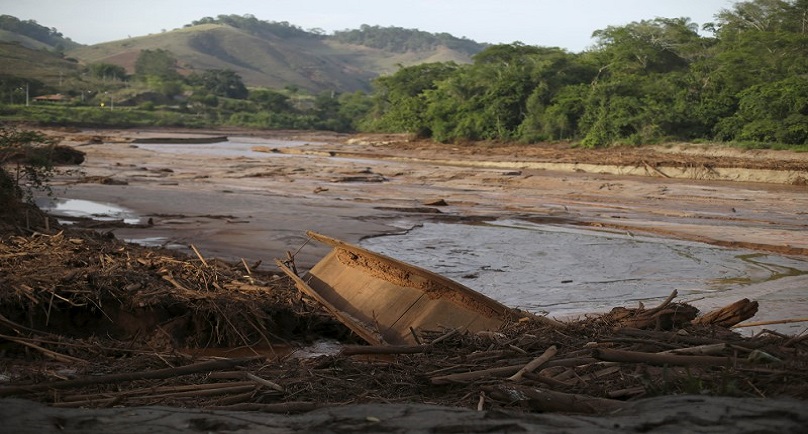Image: A boat is pictured in Rio Doce (Doce River) after a dam, owned by Vale SA and BHP Billiton Ltd burst, in Santa Cruz do Escalvado, Brazil, November 12, 2015. REUTERS/Ricardo Moraes
(This version of the story corrects paragraph 20 to Porgera mine “once considered”, not is “working on”, mixing tailings with coarse waste rock and mud to create a product that can be stored on the surface in dumps, and adds current technology. Corrects paragraph 21 to “a different” wet and dry disposal technology to make clear that Teck Resources does not use the same system as considered at Porgera.)
By James Regan and Susan Taylor
SYDNEY/TORONTO (Reuters) – A deadly mud slide at an iron ore mine in Brazil has reignited calls for safer ways to dispose of millions of tonnes of ore waste held back by man-made dams.
The disaster at the Samarco iron ore mine is only the latest in a series involving tailings – waste in mining parlance – that have devastated the environment, and in the case of Samarco, killed at least 11 people and left another 12 missing.
Tailings are typically a mud-like material and their storage and handling has become a major safety and environmental issue, since they can be toxic and may need to be kept isolated.
The Nov. 5 disaster has been termed an “environmental catastrophe” by Brazil after sending waste across two states and liability could fall on Samarco’s joint owners Vale and BHP Billiton.
BHP Billiton’s chief executive said the miner was reviewing all of its dam facilities and that the companies involved in Samarco would set up an inquiry with submissions from a wide range of experts, including on the history of tailing dams.
“That is why we will be entirely open with the findings of this report to hope that regulators and companies around the world benefit from that learning, so that something like this never happens again,” Andrew Mackenzie told an analysts call.
In Brazil, at least, the industry could face tougher rules after a congressman said a proposal for a new mining code would include stricter regulations for tailings dams and could make dry processing obligatory.
Alternative engineering known as “dry stack” is often put forward as a way to mitigate disasters such as Samarco.
The process removes water from spent ore using vacuum or pressure filters, allowing tailings to be stacked and better controlled.
Advocates say it can also curb waste seepage into groundwater that risks extending environmental liability for an operator long after a mine has run its course.
But partly due to cost it is rarely employed, meaning that thousands of wet tailing dams have been built with more planned.
There are 839 tailings dams in the United States alone and some 3,500 worldwide, according to the U.S Army Corps of Engineers and the United Nations.
DRY STACKING ECLIPSED
A tailings dam rupture at the Mount Polley copper mine in British Columbia, Canada, 15 months ago led experts to recommend that mines in the province use the best available technology, including dry stacking.
“Mount Polley started this big cry for dry stack, which is an entirely different form of tailings deposition but it often doesn’t work for any number of reasons,” said Lindsay Newland Bowker, a policy advisor and consultant on mine tailings waste.
Toronto-listed Seabridge Gold this year rejected dry stacking for a new mine in British Columbia, concluding it wasn’t feasible in wet, mountainous regions.
Even so, some are using the technology.
The Greens Creek gold mine in Alaska was among the first to use it. The La Coipa mine in Chile’s Atacama Desert and Hudbay Minerals’ proposed Rosemont copper mine in the U.S state of Arizona also plan to employ dry stacking.
A drying process at Australia’s Karara iron ore mine leaves a chemically inert material that is stacked on a patch of outback desert before being returned to the soil.
“Where we are seeing dry stack technology being more embraced is in areas where water is scarce,” said Dirk Van Zyl, professor of mining engineering at the University of British Colombia.
“COMES DOWN TO ECONOMICS”
The Porgera mine in Papua New Guinea, which is jointly owned by Barrick Gold Corp and China’s Zijin Mining Group, once considered mixing tailings with coarse waste rock and mud to create a product that can be stored on the surface in dumps. This was never implemented and instead a plant at the mine removes coarser content from tailings, which is then mixed with cement and pumped underground. The finer tailings mix is then discharged in a river.
A different wet and dry disposal technology is already being used by Canada’s Teck Resources Ltd at its Elkview coal mine, while the Silvertip lead mine in British Columbia will use a combination of dry and underground storage.
John Werring senior science and policy advisor with the David Suzuki Foundation, a Canadian environmental group, said more mines might use dry stacking if governments stopped approving conventional tailings dams and pushed companies to come up with alternatives.
“But it always comes down to economics,” Werring added.
Nonetheless, failure to contain mine waste can be costly.
During construction of Papua New Guinea’s OK Tedi copper mine the tailings dam failed and waste was directly discharged into the creeks running into two rivers, destroying thousands of hectares of forest and inundating villages and vegetable patches.
In 1996, then-owner BHP Billiton agreed to a $400-million out-of-court settlement for the land holders near the mine and five years later divested its majority interest.
(Editing by Ed Davies)
Copyright 2015 Thomson Reuters. Click for Restrictions.


